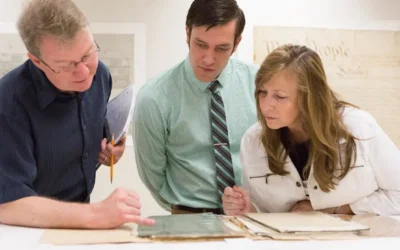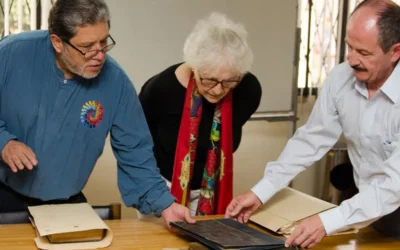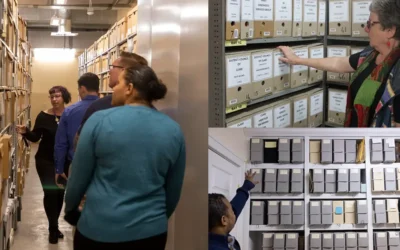Copyright Fundamentals for Cultural Heritage Institutions
Margot Note
Rights management has significant implications for archival collections. If you have documents or images in your possession, you might believe you own the rights to them. However, even though you may physically have the items, the creator of the documents retains the legal copyright, sometimes for much longer than you would assume.
Educating Everyone About Copyright
I once received a call from a potential client who wanted to hire me to digitize, process, and create a database for approximately one million letters in support of a documentary project. When I asked who owned the copyright of the letters, my client said that the recipient’s son did—because he had physical possession of them. I advised them that they would have to seek permission from the people who wrote the letters before digitizing and publishing them online because the writers still owned copyright over the documents. The amount of work and resources required to use these materials made the project unachievable.
Our conversation reminded me that most people lack an understanding of the complex issues regarding copyright. One of our duties as information professionals is to educate our users, our colleagues, and our leadership teams about copyright as it applies to our collections.
Copyright and the Public Domain
Copyright is an aspect of intellectual property that defines the rights of content producers and content consumers. It is intended as a limited monopoly permitting creators to profit from their efforts and, eventually, for the public to freely use creative works—with the idea that such usage will inspire new creation benefitting society. When a creative work is no longer subject to copyright protection, it is in the public domain.
Fair Use
Fair use is a concept unique to United States law that allows users to copy an otherwise protected work without permission from the copyright owner and without the use being deemed an infringement. Other countries have a similar concept called fair dealing, but it is more restrictive. Fair use allows users to sample from sources in a way that enhances the appreciation of the works without infringing on their integrity. Fair use is only available for limited applications such as research and teaching (including multiple copies for classroom use). For instance, I advise my research methods students that fair use permits them to use archival materials in their papers, but they may have to seek permission to include those same materials if they decide to publish their work.
Some Guidelines
Here’s a summary of current United States copyright law, based on information from the Copyright Advisory Network of the American Library Association’s Office for Information Technology Policy:
A document may be in the public domain and thus free from copyright restrictions if the item was:
- first published before 1923
- created after 1922 and before 1978 and published without a © notice
- created after 1922 and before 1964, published with a © notice, but not renewed after 28 years
- published after 1977 and before 1989 without a © notice and subsequent registration
A document will be copyrighted for 95 years after publication if the item was:
- created after 1922 and before 1964, published with a © notice and registered after 28 years
- created after 1963 and before 1978 and published with a © notice
The copyright belongs to the author or the author’s heirs for the author’s lifetime plus 70 years, if the item was:
- created (unpublished) after 1977 and was first published before 2003
- published after 1977 and before 1989 without a © notice but registered within five years, or published with a © notice
- published in 1989 or after with or without a © notice
For unpublished works, it is best to err on the side of the copyright being held during the author’s lifetime plus 70 years.
Securing Copyright
Most archival institutions select items for digitization in which they own copyright or that have passed into the public domain. Depending on the resources available, some institutions may wish to either secure copyright for the items in their care or investigate copyright if the rights are unknown. However, this is a time-consuming and expensive process.
If permissions are not forthcoming for copyrighted sources, the materials cannot be reproduced and the focus of the project must change. If there are limited means for copyright investigation, information professionals should concentrate on items whose rights are owned by the institution. Additionally, from a risk management perspective, eliminating materials that may be under copyright nullifies the danger of infringement.
Protect Your Rights
Once materials images are made available online, the organization hosting them should protect their rights. Copyright and legal issues are exacerbated by the openness and ubiquity of the Internet. The potential for unauthorized use of materials online means that access cannot be managed as carefully as in a traditional setting like a reading room, where access restrictions allow sensitive materials to be presented with guidance.
Access, when not universal, must be managed through passwords, user fees, or other means. Diverse capabilities for viewing, downloading, and printing may be offered to different sets of users. The simplest method for protection is to include a copyright statement and usage guidelines on the delivery medium. For example, on a website, the user would have to agree to abide by certain rules before viewing the images. Access could also be limited to registered users or users logging on from the institution’s domain name or IP address. Additionally, institutions may insert captions, add watermarks to the images, or encrypt them.
Seek Legal Advice When Necessary
Copyright decisions must be made at the institutional level. Information professionals should have access to training and up-to-date information and should always keep accurate, comprehensive documentation about all legal matters relating to their collections. The presentation of material on the Internet is inherently international, so information professionals should be aware of the broader context of global access and use of the materials online. It is worthwhile, especially for a large project, to have legal advice concerning copyright as the law varies considerably internationally. When you are in doubt or the copyright is complicated, always seek the advice of a copyright attorney.
Margot Note
Similar Posts
Enhancing Collaboration; Methods for Archivists
Archivists can enhance collaboration through user-centric approaches and efficient processing methods based on customer service principles.
Navigating Selection in Archival Practice
The archival selection process is far from straightforward, given the limitations of long-term preservation and ongoing accessibility challenges.
Responsible Stewardship in Archival Practice
Responsible stewardship is a philosophy that guides the actions and decisions of archivists in safeguarding collective memory.
A Modern View of a City’s History via ArchivEra
Brief success story on City of Regina Archives’ use of ArchivEra to manage collections of legal, historical, administrative or financial significance
Hosting service
Enjoy all of the benefits of your Lucidea solution with secure, reliable, stress free hosting
Programs & incentives
No matter your size or budget, we’ve got you covered, today and tomorrow



